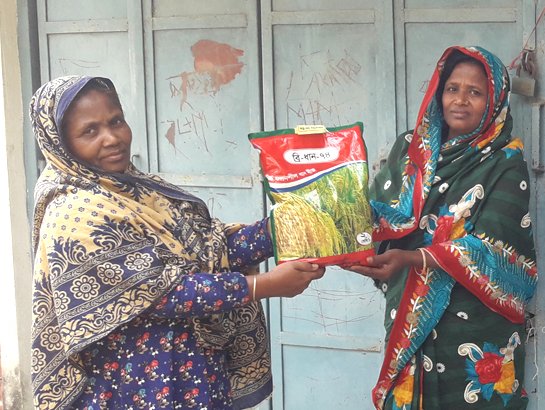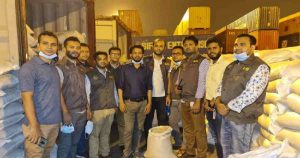Syeda Nuhara, HarvestPlus Bangladesh
Alema Begum, 40, lives with her son and his family in Rangpur district, Bangladesh. In 2008, a volunteer from RDRS Bangladesh, a nongovernmental organization, made her an offer that set in motion a journey for Begum and her community in improving the nutritional status of their families by switching to biofortified zinc rice. By 2020, about 5000 farmers from Begum’s locality were cultivating the BRRI dhan74 zinc rice variety, which now covers around 80 percent of the locality’s rice-cultivating area. Most of the villagers have started incorporating zinc rice into their daily diets. Begum played a central part in making this happen.
RDRS Bangladesh was the program implementing partner of HarvestPlus Bangladesh, working on introducing biofortified zinc rice seeds in the country. RDRS had proposed that Begum become a member of a “union federation” (UF) in her union council (these councils are the smallest rural administrative and local government units in Bangladesh).
RDRS established UFs as grassroots associations for the lowest-income and vulnerable populations to help them with better social organization. Villagers are brought together into groups of 15‐20 members in each union council to form a UF. RDRS plays a “partner‐guardian” role until the federations are adequately developed and capable of managing their affairs independently. The association allows people to attain greater collective strength, improve unity and cooperation, and allows their membership and community to evolve as a more productive agency for achieving broader objectives of sustainable development.
Leadership in a Farmer’s Organization
Within a very short time after joining the Alompur Union Federation, Begum became the secretary of the executive committee, serving from 2009-2014. In 2014, the members and representatives of the Alompur federation selected Begum as their acting chairperson, a role she continues to serve. She spends most of her time working with the federation and considers it her family. Currently, Begum is in her fourth term of chairpersonship and looks after a total of 1200 members in her federation.
In 2014, Begum learned about zinc rice in a meeting of a neighbouring Hariarkuthi federation arranged by RDRS Bangladesh. She got to know about the nutritional benefits of zinc in rice. She learned that zinc is necessary for brain development in children and can strengthen the immune system. Begum was also briefed about the biofortified variety of zinc rice. Besides their nutritional benefits, the high yield of the biofortified varieties motivated her to engage in zinc cultivation and dissemination activities.
“I started concentrating on zinc rice cultivation and dissemination. I thought about the health and nutritional difficulties of my locality, and the diseases like digestive problems, diarrhoea, poor immunity, and health conditions that were prevalent in my community. I started realizing that rice is the easiest and cheapest way to add zinc to our diets, especially when compared to other costlier sources of zinc like milk, egg, meat, and fruits,” explained Begum.
Reaching Farmers
Begum distributed zinc rice to 1000 farmers in her locality from her federation, with the support of HarvestPlus Bangladesh and RDRS Bangladesh. Initially, she distributed BRRI dhan62 seed. When the number of farming families cultivating zinc rice gradually increased due to her advocacy efforts, the federation set up a demonstration zinc rice plot, arranged farmer field days, and created awareness campaigns among the farmers about zinc rice.
Under Begum’s leadership, the federation disseminated information about zinc rice by discussing it in federation group meetings, displaying the varieties on posters, and publicly disseminating the nutritional benefits of zinc rice to the community. Begum even went forward and promoted zinc rice among her relatives and developed three seed entrepreneurs from her federation. All such efforts and the experience of demo farmers created increased demand for zinc rice in her locality.
“To meet the demand for zinc rice in 2020, I collected 150 kilograms of seed from the distance market and sold it to interested farmers. Last season, more than 50 zinc rice producers had saved their seeds and transplanted them in the current season,” she said. “Many of these farmers also sold their saved seeds to neighbouring farmers, thereby helping them in the further dissemination of zinc rice.”
“The seed entrepreneurs of my federation were also able to sell around half a ton of zinc rice seed. The demand for the new biofortified seeds is picking up. There are days when I fail to meet seed requirements and had to connect the rest of the interested producers with district-level seed entrepreneurs,” explained Begum.
Developing Seed Entrepreneurs
One of the zinc-rice seed producers and entrepreneurs, Sukumer Roy of Taragonj district, also reported that demand for zinc rice seed had increased exponentially since 2018. He said: “In 2020, I produced 5 tons of zinc rice seed through my brand, Desh Traders. I have already sold out 4.5 tons of my production and I am very hopeful to sell the rest amount within a short period,” said Roy
Similar to Desh Traders, around 10 other seed entrepreneurs in Taragonj are engaged in marketing around 50 tons of zinc rice seed these days. Begum played a significant role in generating demand for zinc rice. She initiated zinc rice seed production through her federation. She has also applied for a seed production license to a seed certification agency and has already transplanted nine acres of land for seed production of zinc rice (BRRI dhan74) this season.
The farmers also started showing interest in zinc rice cultivation because of its resistance to disease infestation and low production costs. Even the producers and farmers who consume this variety feel that diarrhoea among their children has become less frequent. Apart from diarrhoea, they also claim that the prevalence of other diseases in their families has also declined. They attribute this improvement to the consumption of zinc rice.
One of the Begum’s neighbouring zinc rice producers, Emdad Sorder, reports: “I transplanted zinc rice on 0.6 acres of land and got 2200 kg yield. I am happy to cultivate zinc rice, especially BRRI dhan74. The BRRI dhan74 variety provides an early yield in comparison to the current mega non-zinc rice variety BRRI dhan29. Even though I got 200 kg yield less from BRRI dhan74, I have personally witnessed other benefits like less disease occurrence, low production cost, high quality, better taste, and other nutritional benefits.”
Begum said that being involved in the federation has helped her improve her standing in many ways: “Before joining the federation I did not even have the confidence to talk with others. I did not have any wardrobe nor did I have any contacts in the government offices. Today I frequently go to different government and non-governmental offices at the district level and I am able to carry myself confidently in my meetings with officials. I have learned so much about rules, regulations, and law through the chairpersonship at the federation. This added knowledge even helped me create awareness amongst my acquaintances about other social issues about child marriage, health, and nutrition.”
Begum is also excited for the future: “The growers get the benefit of zinc so they will continue their production, at least up to their family consumable amount of grain. I am very excited to observe that the popularity of zinc rice is spreading rapidly amongst other localities of my district,” she said.
Almost 30 percent of the Bangladeshi population suffers from inadequate zinc intake. Zinc deficiency contributes to stunting and a loss of appetite, lowers immunity, and increases the risk of diarrheal disease and respiratory infections. According to research, the zinc-biofortified variety of rice, Bangladesh’s most popular staple food, can provide up to 60 percent of daily zinc needs if eaten regularly. According to the World Bank, Bangladesh loses over USD 700 million in GDP annually to mineral and vitamin deficiencies. – HarvestPlus




